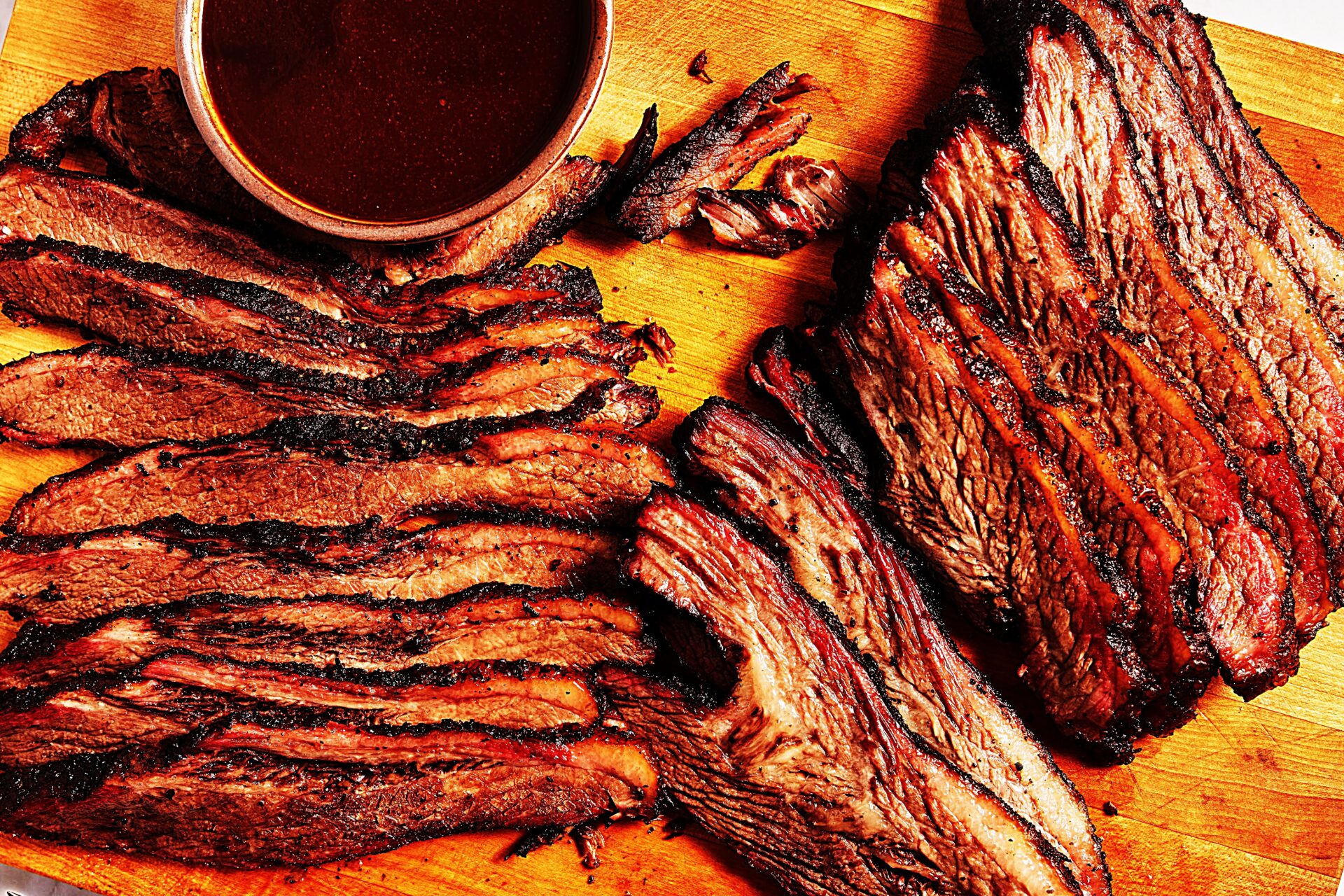Smoked beef brisket is the ultimate summer barbecue treat and a great way to wow your friends and family with your outdoor cooking skills. This one is juicy with spicy bursts from the black pepper rub, balanced by just the right amount of smoke, and tangy sweetness from the root beer and maple barbecue sauce. And while the brisket serves a crowd, it also freezes well if you want to keep it all to yourself! You’ll need a whole (packer) brisket, which includes both the “point” or “deckle” muscle and the thinner, more uniform muscle called the “flat.” You can order the brisket from a butcher or sometimes buy it from a big-box store like Costco. To save yourself time, ask the butcher to trim the fat on the brisket to an even ¼ inch, remove any clumps of hard fat, and remove the thin membrane from the meatier side of the cut. Follow the manufacturer’s directions for your smoker to build the fire and maintain the heat. You’ll need 15 egg-size chunks of hickory wood, a large aluminum foil pan (unless your smoker has a built-in water pan), heavy-duty foil, a spray bottle, and an insulated cooler to let the meat rest. If you’re using a bullet-style charcoal smoker, you’ll need 2 large bags of charcoal (preferably lump style) for this recipe. If you’re using a pellet smoker, go with hickory pellets; the hickory wood chunks are optional (and only use 7-8 total).
Satisfy your sweet tooth with this easy-to-make recipe for Hickory Smoked Brisket with Root Beer-Maple BBQ Sauce.
1. Info for Hickory Smoked Brisket with Root Beer-Maple BBQ Sauce
- Cook Time: 10 Hr 0 Min
- Total Time: 10 Hr 0 Min
- Servings: 12
- Calories: 892.87 kcal
2. Ingredients for Hickory Smoked Brisket with Root Beer-Maple BBQ Sauce
- beef brisket
- kosher salt
- black pepper
- packed brown sugar
- ketchup
- root beer
- maple syrup
- apple cider vinegar
- chili powder
- garlic powder
- ground cumin
3. Directions:
- If the brisket hasn’t been trimmed, cut the fat to an even ¼ inch. (The fat helps to protect the meat from drying out.) On the meatier side, slide a thin knife under the thin membrane and cut it off so that the grain of the meat is visible. Also trim off hard clumps of fat (if any) that are on the sides of the brisket.
- Combine salt, pepper, and 3 tablespoons of the brown sugar in a small bowl. Sprinkle the mixture evenly all over the brisket, patting it in. Let stand at room temperature for 1 hour.
- Meanwhile, heat a smoker to 250° to 275°F as recommended by the manufacturer, and add 7-8 egg-sized hickory wood chunks. (For a bullet-style charcoal smoker, fill the charcoal reservoir three quarters full, add 7-8 hickory wood chunks, then top with enough charcoal to fill the smoker.) If your smoker has a water pan, fill it three-quarters full with warm water. Or just set an aluminum foil pan in the smoker and fill it most of the way with warm water.
- Following the insertion guide on the Yummly Smart Thermometer app, insert the thermometer horizontally into the thickest part of the brisket until the metal is completely covered.
- When you see smoke coming from the smoker, lightly spray the brisket all over with water using a spray bottle (the moisture will help the brisket absorb smoke and develop the bark). Place the brisket fat side up on the cooking grate. Choose the Manual Cook setting (rather than Beef) on the Yummly Thermometer app and set the cook temperature to 160°F. Close the lid on the smoker.
- Cook at 250° to 275°F with the lid closed, adding more fuel and refilling the water pan if needed, until the Yummly Thermometer app tells you that the brisket has reached 160°F, 3-5 hours. The surface color of the meat should be a rich mahogany, which means the brisket has developed a bark and the brisket will no longer absorb much smoke.
- The brisket cooking tends to stall at 160°F. To prevent this, remove the brisket from the smoker and lightly spray it with water. Tightly wrap the brisket in a double layer of heavy-duty aluminum foil and make a small hole to allow the black cap of the Yummly Thermometer to stick out so the bluetooth signal won’t be blocked.
- Return the wrapped brisket, fat side down, to the smoker. Using the Manual Cook setting on the Yummly Thermometer, set the temperature to 200°F. Cover the smoker and continue cooking at 250° to 275°F, adding fuel and refilling the water pan if needed, until the app tells you that the brisket has reached 200°F, 3-4 hours longer. The total time to smoke a beef brisket is 6-9 hours, depending on the size of the brisket and the temperature of the fire. You know the brisket is done when you press it with your fingers through the foil (protecting them with a clean towel) and the meat is so tender it feels like your fingers will pierce the meat. Tenderness is the best indicator of doneness rather than temperature, so if the brisket doesn’t feel tender enough, set the Yummly Thermometer to 205° to 210°F and continue cooking.
- Transfer the brisket, still wrapped in foil, to an insulated cooler. Close the cooler and let the meat rest 1 hour for the juices to even out.
- While the brisket rests, make the sauce. Combine remaining 2 tablespoons brown sugar, the ketchup, root beer, maple syrup, vinegar, chili powder, garlic powder, and cumin in a medium saucepan over medium-high heat. Bring sauce to a boil, reduce heat to medium, and simmer, stirring occasionally, until slightly thickened, 8-9 minutes.
- Unwrap brisket and set it on a cutting board. Transfer meat juices to a measuring cup and skim and discard fat.
- Starting on the thin (flat) side, slice brisket across the grain ⅓ to ½ inch thick. When you reach the part of the brisket where the thin side (the flat) meets the thick side (the point), stop and transfer slices to a platter, keeping them together so they don’t dry out. (Or keep slices on the board if it’s a large one.) Rotate the point (the remaining brisket) 90 degrees so that the side you were slicing is now facing away from you. Slice the point across the grain, then transfer to the platter. Drizzle the brisket with some of the meat juices and serve with the barbecue sauce.

